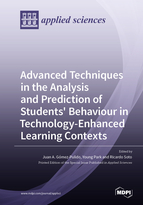Advanced Techniques in the Analysis and Prediction of Students' Behaviour in Technology-Enhanced Learning Contexts
A special issue of Applied Sciences (ISSN 2076-3417). This special issue belongs to the section "Computing and Artificial Intelligence".
Deadline for manuscript submissions: closed (31 May 2020) | Viewed by 115296
Special Issue Editors
Interests: optimization and computational intelligence; machine learning; reconfigurable computing and FPGAs; wireless communications; bioinformatics
Special Issues, Collections and Topics in MDPI journals
Interests: personalized recommender systems and prediction systems; personalized and advanced Web search; formal concept analysis and its applications to software engineering; Web search and data mining; software reuse; semantics-based program analysis
Special Issues, Collections and Topics in MDPI journals
Interests: discrete and continuous optimization; metaheuristics; machine learning; artificial intelligence; decision system
Special Issues, Collections and Topics in MDPI journals
Special Issue Information
Dear Colleagues,
Analysing and predicting individuals' behaviour are important topics in academic environments, especially after the increasing development and deployment of software tools for supporting learning stages. The automation of many processes involved in the usual students' activity allows for processing massive volumes of data collected from teaching-enhanced learning (TEL) platforms, leading to useful applications for academic personnel. In this way, monitoring and analysing students' behaviour are key activities required for the improvement of students' learning. Recommendations of activities, dropout prediction, performance and knowledge analysis, and resources optimization, among other students-centred interests, are complex tasks that involve many elements that need to be considered. Therefore, it becomes necessary that these efforts search for support from other fields in the computational science that have demonstrated a high effectiveness when handling data and processes that are strongly interconnected. Data mining, big data, machine learning, deep learning, collaborative filtering, and recommender systems, among other fields related to intelligent systems, allow for the development of advanced techniques that provide a significant potential for the above purposes, leading to new applications and more effective approaches in the analysis and prediction of the students' behaviour in academic contexts.
This Special Issue provides a collection of papers of original advances in the analysis, prediction, and recommendation of applications propelled by artificial intelligence, big data, and machine learning, especially in the TEL context. Papers about these topics are welcomed.
Prof. Dr. Juan A. Gómez-Pulido
Prof. Dr. Young Park
Prof. Dr. Ricardo Soto
Guest Editors
Manuscript Submission Information
Manuscripts should be submitted online at www.mdpi.com by registering and logging in to this website. Once you are registered, click here to go to the submission form. Manuscripts can be submitted until the deadline. All submissions that pass pre-check are peer-reviewed. Accepted papers will be published continuously in the journal (as soon as accepted) and will be listed together on the special issue website. Research articles, review articles as well as short communications are invited. For planned papers, a title and short abstract (about 100 words) can be sent to the Editorial Office for announcement on this website.
Submitted manuscripts should not have been published previously, nor be under consideration for publication elsewhere (except conference proceedings papers). All manuscripts are thoroughly refereed through a single-blind peer-review process. A guide for authors and other relevant information for submission of manuscripts is available on the Instructions for Authors page. Applied Sciences is an international peer-reviewed open access semimonthly journal published by MDPI.
Please visit the Instructions for Authors page before submitting a manuscript. The Article Processing Charge (APC) for publication in this open access journal is 2400 CHF (Swiss Francs). Submitted papers should be well formatted and use good English. Authors may use MDPI's English editing service prior to publication or during author revisions.
Keywords
- Teaching-enhanced learning and teaching
- Personalized learning
- Intelligent tutoring Systems
- Data mining and big data analysis
- Intelligent systems
- Machine and deep learning
- Recommender systems
- Collaborative filtering
- Software tools
- Performance prediction
- Knowledge analysis
- Optimization








